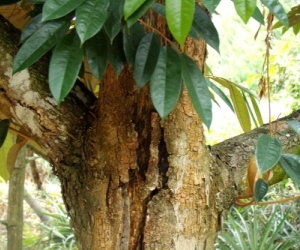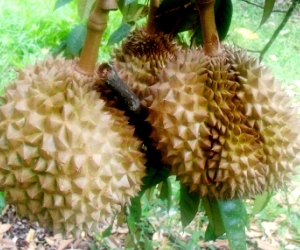Caused by the same fungus Phytophthora palmivora, the disease is known by various names depending on the plant organ that is affected.
This is the most feared disease which affects different parts of durian in all stages of development.
It is responsible for the death of many durian trees in the orchards located in several countries.

Root rot affects the root which results to the weakening of the tree and, ultimately, death.
Patch canker or stem canker starts with a gum-like substance that exudes from a lesion on the bark of the stem.
This lesion enlarges and when it is able to surround the entire trunk, the branches start to die back.
Eventually, the tree defoliates and die.
This disease commonly infects mature trees during the wet season.
The infection starts from wounds, cracks, or entry holes of shot-hole borers on the stem.
Fruit rot infects both immature and mature fruits.
Damage symptoms are characterized by watery patches on the rind of the fruit which later become dry and change in color to dark brown and black.
Whitish, cottony mycelia, and sporangia are found on the lesions. Affected fruits that are immature drop.
Foliar blight or leaf blight commonly affects durian plants in the nursery.
The disease is characterized by water-soaked spots on the leaves which turn black and develop into large necrotic areas.
Infected leaves are blighted, drop prematurely, and the seedling begins to die back.
How to Prevent, or at Least Minimize, the Incidence of Phytophthora?
To prevent, or at least minimize, the incidence of Phytophthora, an integrated system of prevention and control should be effected.
These measures include the following:
1. Provide the needs of the trees to enhance vigor. This starts with the selection of a suitable site and includes proper plant spacing, nutrition, water supply, weeding, pruning, and fruit thinning.
2. If soil pH is too acidic, adjust to 5.5-6.5 by lime application.
3. Avoid excessive relative humidity by such practices as regular weeding, proper pruning including the removal of the lowermost branches, sanitation of the undercanopy, and thinning out of excess trees to avoid overlapping of canopies.
4. Construct drainage canals to reduce standing water, surface runoff, and underground water during the rainy season.
5. Monitor regularly and apply sanitation procedures. Collect damaged and diseased fruits, stems, and other plant parts. Dispose of properly by burning or burying.
6. Avoid mechanical damage to the stems. Should there be any, it should be painted immediately with a paste of systemic insecticide.
7. Apply protective fungicidal sprays every 15 days in the rainy season. (Note: Carpio (n.d.) reports that a study conducted by a team of researchers led by Prof. Belly T. Dionio of the Univerisity of Southeastern Philippines, Davao City, revealed that botanical pesticide from kamantigui or garden balsam (Impatiens balsamina) is effective in controlling the Phytophthora disease of durian).
Insect Pests and Their Control
Common insect pests attacking durian are the fruit borers (Tonica lagaropis and Conogethes punctiferalis), shot-hole borer, and psyllids.
Although it is only the fruit borer that has a significant contribution indirectly reducing durian yield, the other insect pests can play an indirect role in increasing the incidence of Phytophthora infection either by creating entryways for the fungal pathogen or by decreasing the resistance of the trees against the disease.
External symptoms of fruit borer infestation are visible on the durian fruit.
These include brownish feces and holes on the rind of the fruits.
The holes are made by the caterpillars which bore into the fruit. The caterpillars are hatched from eggs laid on the rind by the female moth.

Other host plants of the durian fruit borer are cacao, chico, citrus, jackfruit, papaya, rambutan, and eggplant.
Prevention and control practices against the durian fruit borer:
1. Light trapping to reduce the adult population.
2. Remove and burn or bury infested and fallen fruits.
3. Prune the fruits to a single fruit per bunch because the adult moth prefers to lay eggs on the rind between adjoining fruits.
Otherwise, separate adjoining fruits by placing a wedge (stick or any material) in between them.
4. Bag the fruits 2-3 weeks after fruit set with plastic bags provided with slits or holes to drain water that may accumulate inside.
The bags will prevent the female moths from laying their eggs on the rind.
Remove these bags about 2 weeks before harvest because bagged fruits have unnatural pale colors.
5. Eliminate alternate hosts from the orchard when the durian trees are about to commence fruiting or include these plants in the pest control management program.
6. Spray insecticides when the infestation is heavy.
The use of chemical pesticides should be considered with extreme caution because they can kill the natural enemies of insect pests.
The shot-hole borer (Xyleborus sp.) is a tiny black or brown beetle that boreholes in the bark and feeds on the cambium layer.
It is of particular significance to the subject of disease control in durian because it is associated with Phytophthora.
Control management strategies include maintenance of the vigor of durian trees and scraping of infested portions followed by the application of insecticides.
The psyllids (Allocarsidara incognita) lay eggs on the unopened leaves.
The nymphs have body coverings that appear cottony white.
They suck the young leaves causing yellowish spots and, if not controlled, severe infestation may cause dying of the tree.
REFERENCES
Armenio, R.B.Jr. 2006. Durian production. Retrieved December 29, 2010 from http://hvcc.da.gov.ph/pdf/durian_prodn.pdf.
Carpio, A. n.d. Botanical fungicide from ‘kamantigue’ controls Phytophthora disease of durian. Retrieved December 29, 2010 from http://pcarrd.dost.gov.ph/s&t;%20highlights/2007/oct/snt1007_04.htm.
Cunningham, T. 2000. Durian market report. Upland Development Programme in Southern Mindanao (UDP). Retrieved December 28, 2010 from www.saveuplands.org/plugin/library/download.php?id=228.
Food and Fertilizer Technology Center (FFTC). 2005. Managing Phytophthora disease of durian. Retrieved December 29, 2010 from http://www.agnet.org/library/pt/2005007/.
http://www.bpi.da.gov.ph/NSIC/2000-pubfcrop.html, accessed December 28, 2010.
http://www.dit.go.th/agriculture/durian/situate.htm, accessed December 28, 2010.
Pamplona, P.P. 2006. Visits to progressive fruit farms are highly rewarding. Agriculture Monthly Magazine (September 2006). pp. 58-60.
Provido, N.T. 2006. Practical ways to control Phytophthora in durian. Agriculture Monthly Magazine (October 2006). pp. 4-5.
Verheij, E.W.M. and R.E. Coronel (eds.). 1992. Edible fruits and nuts. Plant Resources of South-East Asia No. 2. Bogor, Indonesia: Prosea Foundation. pp. 157-161.
I Plant Fruit Trees I Durian Crop Info I Growing Durian I Safety Precautions I

Hope this blog is still live. Keen to learn as much about quality durian farming as I can. Thx